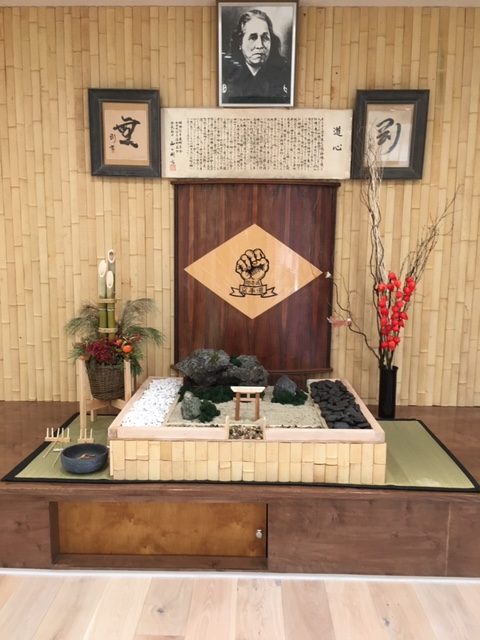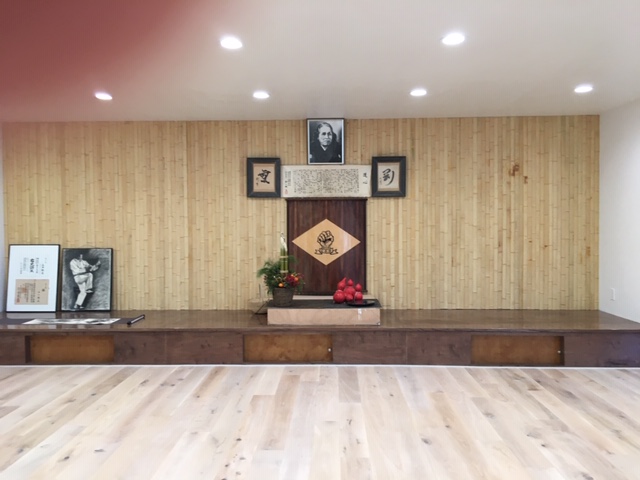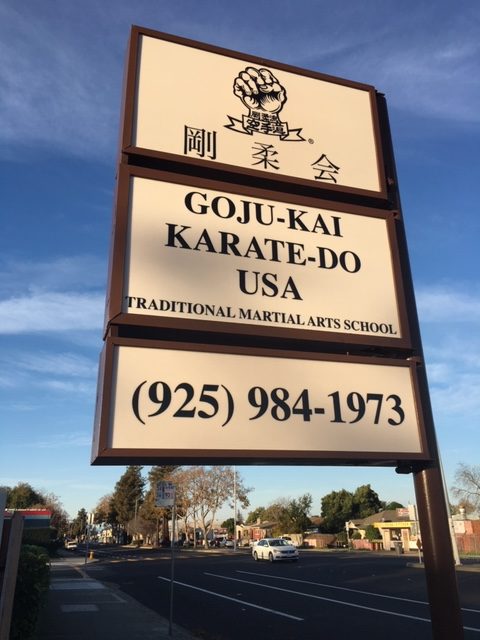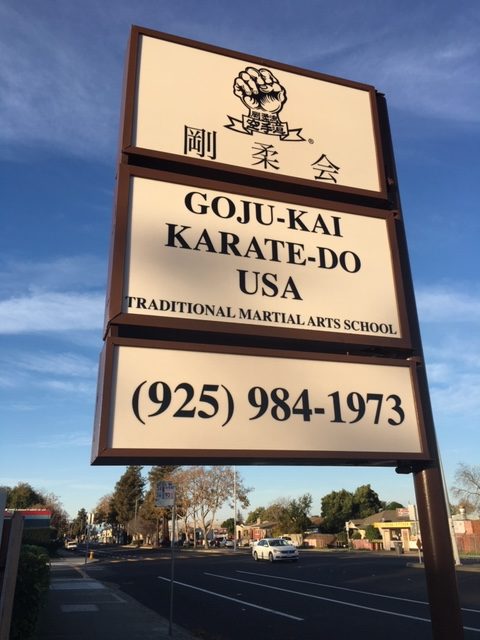HONBU DOJO
本部道場
The physical performance of the art of karate is a branch of philosophy representing zen buddhism. I am reminded of the principles of beauty and artistic taste in the world of Wabi & Sabi. It has been such a fortunate occasion for me to create this miniature zen garden at my humble Hayward Dojo.
Gosei Yamaguchi


HONBU DOJO
本部道場

Dojo, or 道場 means, in Japanese, a facility provided for practicing discipline. Traditionally the martial arts practitioners have referred to their workout site as “dojo.” Honbu, or 本部 means headquarters. Thus, “honbu dojo” is the main facility that is located at where the chief instructor conducts his instruction and administration.
Location
Administrative Office:
Goju-Kai Karate-Do, U.S.A., National Headquarters
187 Monte Carlo Way, Danville, California 94506 U.S.A.
Tel. (925) 984-1973

Training Facility:
Goju-Kai Karate-Do, USA
415 – 419 A Street, Hayward California 94541 USA
Tel. (925) 984-1973
|
CLASS HOURS | ||
|
JUNIOR CLASS |
ADULT CLASS | |
|
MONDAY | 7:00 PM — 9:00 PM | |
|
WEDNESDAY | 7:00 PM — 9:00 PM | |
|
FRIDAY | ||
|
SATURDAY | 11:00 AM — 1:00 PM | |
|
FEES | ||
|
INITIATION FEES |
$20.00 | |
|
MONTHLY DUES: | ||
|
ADULTS |
$70.00 | |
|
JUNIOR (15 YEARS OLD AND YOUNGER) |
$50.00 | |
|
RANK | ||
|
STANDARDIZED RANKING SYSTEM | ||
|
Introductory Level (無段者) | ||
|
10th kyu: (無級) |
White Belt |
No Rank Holders |
|
9th kyu: (九級) |
with one green stripe |
(白帯) |
|
8th kyu: (八級) |
with two green stripes |
(白帯) |
|
7th kyu: (七級) |
with three green stripes |
(白帯) |
|
6th kyu: (六級) |
Green Belt with one brown stripe |
(緑帯) |
|
5th kyu: (五級) |
with two brown stripes |
(緑帯) |
|
4th kyu: (四級) |
with three brown stripes |
(緑帯) |
|
3rd kyu: (三級) |
Brown Belt with one black stripe |
(茶帯) |
|
2nd kyu: (二級) |
with two black stripes |
(茶帯) |
|
1st kyu: (一級) |
with three black stripes |
(茶帯) |
|
Black Belt Level |
有段者 | |
|
Shodan Ho:(初段補) |
First degree interim |
(黒帯) |
|
Shodan: (正初段) |
First degree |
(黒帯) |
|
Nidan Ho (二段補) |
Second degree interim |
(黒帯) |
|
Nidan: (正二段) |
Second degree |
(黒帯) |
|
San Dan Ho(三段補 ) |
Third degree interim |
( 黒帯) |
|
San Dan: (正三段 ) |
Third degree |
( 黒帯) |
|
Yon Dan: ( 四段 ) |
Fourth degree |
(黒帯) |
|
Go Dan: ( 五段 ) |
Fifth degree |
(黒帯) |
|
Roku Dan: ( 六段 ) |
Sixth degree |
( 黒帯) |
|
************************ |
Officials
Followings are the officials of Goju-Kai Karate-Do, U.S.A.:
N. GOSEI YAMAGUCHI
NATIONAL CHAIRMAN
H. DONALD BUCK ,
SECRETARYU
DIN VAN NGUYEN,
GENERAL TREASURER
EXAMINERS FOR RANK EXAMINATION
John Linhoff, Minneapolis, Minnesota
Jon Sylvester, National Headquarters
Steven Chalmers, Spencer Massachusetts
William Lewinski, Mankato, Minnesota
Scott R. Bissen, Minnetonka, Minnesota
ASSISTANT INSTRUCTORS AT THE NATIONAL HEADQUARTERS
Jon Sylvester, Dolores Kofman, Glenn Cooper, Anthony Fabiano,Ted Ianiro, Mark Woodside
Program
Goju-ryu karate contains five progressive programs of instruction. The first is devoted to the warming up exercises used by the goju practitioner. The second, called kihon, or 基本 deals with the fundamentals of blocking, striking and kicking. From kihon, the student progress to kihon ido, or 基本移動 which leads into the two major programs, kata and kumite. Kata is the aesthetic, ballet-like exercise composed of serial patterns. Kumite is the combative, combined-pattrern exercise also referred to as sparring.
Both series of kata ido and nekoashi ido belong to the same category of kihon ido- that of the ido (movement) program. However, they are preparatory programs which function as transitional exercises between the basic programs and the programs of kata and kumite. Kata ido is programmed to facilitate the turning exercises in preparation for fukyu gata, or 普及形, whereas, nekoashi ido is programmed toward footwork exercises in preparation for kumite, or 組手.
The kihon series combines the basic blocking, striking and kicking techniques with basic stances and postures. Because the kihon forms are performed one stance at a time, they are called stationary activity. Although the feet may move to kick during the excution of a form, they return to their original stance upon completion of the technique. Therefore, like the geometric definition of the dot, kihon is characterized by “dimensionless space”.
Kihon ido then puts the forms learned in kihon into simple patterns of movement. These patterns consist of forward and backward movements in straight lines. In geometric terminology kihon ido is characterized by “line demention”.
When the student reaches the kata and kumite programs, he performs his footwork in any direction of plane areas. In other words, the instructional process of goju-ryu is a progressive sequence of dimensional expansions – dots to lines to planes.
The following list shows the order of the goju-ryu programs.
1. Group 1: Warm-up Exercises (予備運動)
The basic idea of warming-up exercises is to start at the farthest place from the heart and to loosen up all the joints of the body without straining the heart. During the exercises, the hands are placed on the belt when they are not being utilized and the feet are paralleled to the width of the shoulders.
They are 18 items and last about 25 to 30 minutes to complete.
Toe joints and Ankles: a. starting with the right foot, alternately bend all the toes down and up ten times; b. bend the big toe up and the other toes down ten times and c. rotate the ankle from the left to the right then reverse the action ten times.
Knee joints: a. close the feet and bend the knees all the way down to the feet (the heels should be flat on the floor) and stand up while stretching knees by supporting with hands ten times: b. rotate the knees from the left to the right then reverse the action ten times.
Ankles and calves: using a parallel stance, first lift the heels up and then place them on the floor standing up only on the heels and pull the entire body back. Repeat the actions ten times.
Legs: spread the legs wide; a. push the right foot firmly against the floor (the toes should be placed on the floor facing the outside); push the heel at a ninety degrees angle toward outside and press the leg down; c. pull the toes up and stand on the heel; the other knee is bent while the hips push down deeply (alternate with both legs.)
Hips, waist, and stomach: spread the legs wide and hold the hands together above the head: a. bend the body forwards to the floor and then backwards: b. rotate the body in a circular movement from the left to the right the reverse the action ten times.
Waist: Mawashi-uke movement: a. twist the body from the left side to the right four times : b. twist the body from the left side of the back of the waist to the right four times: c. twist the body downward from the left to the right four times and d. lean the body backwards while push the hands upward over the shoulders four times.
General exercise push-ups: a. placing the body’s weight first on the fists, do thirty push-ups, keeping the back perfectly straight. b. placing the body’s weight on the fingertips, arch the back and do ten push-ups, using the “dipping” movement.
Fingers: press the open hands together and stretch the palms; b. press the fingers together and stretch the joints, and shake out both hands well.
Shoulder joints: lift the elbows to shoulder level and pull the arms back to stretch the chest.
General exercise: sit-ups; sit on the floor with a partner and clasp legs together; do one hundred sit-ups, without letting the shoulders touch the floor.
Stomach muscles: laying flat on the floor, raise the legs and the neck about six inches from the floor and hold this position for about thirty seconds each time.
Back: laying flat on the floor, roll the legs back over the head and then sit up, pushing the head to the knees (repeat this exercise ten times).
Toes: sitting on the floor, stretch the toes up and down then rotate the ankles (alternate with both feet).
Hip joints: sitting on the floor, raise the right foot up to the chest supporting by hands and repeat the same motion with the left foot ten times.
General exercise: “squats”; using a parallel stance cross the arms and do between thirty and fifty deep-knee bends, keeping the back straight.
Hip joints: using the parallel stance, place the hands on the belt and raise each knee up to the chest starting from the right knee ten times.
Hip joints: using the parallel stance, stretch the right leg up toward the head ten times, keeping the leg straight(repeat the same with the left leg).
Neck: a. place the chin on the chest and stretch the head back ten times, tensing the neck muscles; b. rotate the head in a circular movement first toward the left and then right ten times; and c. turn the head from the left side to the right quickly then reverse the action ten times.
2. Group 2: Kihon (基本)
Kihon I, Kihon II, Kihon III, Kihon IV
KIHON 基本
In Kihon there are four groups of exercises classified according to the level the participants. From a technical point of view,
Kihon No.1 and Kihon No.2 are independent programs. However, Kihon No.3 and Kihon No.4 are preparatory programs for Kumite activity.
Kihon I
Uke Kata
SANCHIN DACHI AGE UKE 三戦立 揚受
SANCHIN DACHI YOKO UKE 三戦立 横受
SANCHIN DACHI JOGE UKE 三戦立 上下受
SHIKO DACHI HARAIOTOSHI UKE 四股立 払落受
Tsuki Kata
SANCHIN DACHI SEIKEN ZUKI 三戦立 正拳突
SHIKO DACHI SHITA ZUKI 四股立 下突
SANCHIN DACHI URA UCHI 三戦立 裏打
SANCHIN DACHI SHUTOU UCHI 三戦立 手刀打
SANCHIN DACHI FURI UCHI 三戦立 振打
Keri Kata
HEIKO DACHI KOGAN GERI 平行立 睾丸蹴
HEIKO DACHI MAE GERI 平行立 前蹴
HEIKO DACHI KANSETSU GERI 平行立 間接蹴
HEIKO DACHI YOKO GERI 平行立 横蹴
2) Kihon II
Uke Kata
SANCHIN DACHI AGE UKE YOKO UKE
SANCHIN DACHI YOKO UKE AGE UKE
SANCHIN DACHI JOGE UKE
SHIKO DACHI HARAIOTOSHI UKE
Tsuki Kata
SANCHIN DACHI NIHON ZUKI
SANCHIN DACHI SANBON ZUKI
Uke Kata Tsuki Kata
SANCHIN DACHI AGE UKE SEIKEN ZUKI JODAN
SANCHIN DACHI YOKO UKE SEIKEN ZUKI CHUDAN
SHIKO DACHI HARAIOTOSHI UKE SEIKEN ZUKI
Keri Kata
SANCHIN DACHI MAE GERI
SANCHIN DACHI YOKO GERI
3) Kihon III
NEKOASHI DACHI KUMITE NO KAMAE
RIGHT FOOT FORWARD
LEFT FOOT FORWARD
Tsuki Kata
NEKOASHI DACHI / SANCHIN DACHI SEIKEN ZUKI
a) RIGHT FOOT FORWARD SANCHIN DACHI SEIKEN ZUKI WITH THE LEFT REVERSE MIDDLE LEVEL STRIKE
b) LEFT FOOT FORWARD SANCHIN DACHI SEIKEN ZUKI WITH THE RIGHT REVERSE MIDDLE LEVEL STRIKE
NEKOASHI DACHI / ZENKUTSU DACHI SEIKEN ZUKI
a) RIGHT FOOT FORWARD ZENKUTSU DACHI SEIKEN ZUKI WITH THE LEFT REVERSE STRIKE
b) LEFT FOOT FORWARD ZENKUTSU DACHI SEIKEN ZUKI WITH THE RIGHT REVERSE STRIKE
NEKOASHI DACHI / SHIKO DACHI SEIKEN ZUKI
a) RIGHT FOOT FORWARD SHIKO DACHI SEIKEN ZUKI WITH THE LEFT REVERSE STRIKE
b) LEFT FOOT FORWARD SHIKO DACHI SEIKEN ZUKI WITH THE RIGHT REVERSE STRIKE
Uke Kata Tsuki Kata
NEKOASHI DACHI / SANCHIN DACHI SEIKEN ZUKI
a) RIGHT FOOT FORWARD SANCHIN DACHI AGE UKE WITH RIGHT UPPER LEVEL BLOCK / SANCHIN DACHI SEIKEN ZUKI WITH LEFT REVERSE STRIKE
b) LEFT FOOT FORWARD SANCHI DACHI AGE UKE WITH THE LEFT UPPER LEVEL BLOCK / SANCHIN DACHI SEIKEN ZUKI WITH THE RIGHT REVERSE STRIKE
NEKOASHI DACHI / SHIKO DACHI HARAIOTOSHI UKE / ZENKUTSU DACHI SEIKEN ZUKI
a) RIGHT FOOT FORWARD SHIKO DACHI HARAIOTOSHI UKE / ZENKUTSU DACHI SEIKEN ZUKI WITH THE LEFT REVERSE SEIKEN STRIKE
b) LEFT FOOT FORWARD SHIKO DACHI HARAIOTOSHI UKE / ZENKUTSU DACHI SEIKEN ZUKI WITH THE RIGHT REVERSE SEIKEN STRIKE
a) LEFT FOOT FORWARD SHIKO DACHI HARAIOTOSHI UKE / ZENKUTSU DACHI WITH THE RIGHT REVERSE SEIKEN STRIKE
b) RIGHT FOOT FORWARD SHIKO DACHI HARAIOTOSHI UKE / ZENKUTSU DACHI WITH THE LEFT REVERSE SEIKEN STRIKE
a) RIGHT FOOT FORWARD SHIKO DACHI HARAIOTOSHI UKE / ZENKUTSU DACHI SEIKEN ZUKI WITH THE LEFT REVERSE SEIKEN STRIKE
b) LEFT FOOT FORWARD SHIKO DACHI HARAIOTOSHI UKE / ZENKUTSU DACHI SEIKEN ZUKI WITH THE RIGHT REVERSE SEIKEN STRIKE
Keri Kata
NEKOASHI DACHI KUMITE NO KAMAE / MAE GERI
a) RIGHT FOOT FORWARD NEKOSASHI DACHI MAE GERI WITH THE FRONT RIGHT FOOT
b) LEFT FOOT FORWARD NEKOASHI DACHI MAE GERI WITH THE FRONT LEFT FOOT
a) RIGHT FOOT FORWARD NEKOASHI DACHI MAE GERI WITH THE BACK LEFT FOOT
b) LEFT FOOT FORWARD NEKOASHI DACHI MAE GERI WITH THE BACK RIGHT FOOT
NEKOASHI DACHI KUMITE NO KAMAE / YOKO GERI
a) RIGHT FOOT FORWARD NEKOASHI DACHI YOKO GERI WITH THE FRONT RIGHT FOOT
b) LEFT FOOT FORWARD NEKOASHI DACHI YOKO GERI WITH THE FRON LEFT FOOT
3. Group 3: Ido (移動)
Kihon Ido, Kata Ido, Kumite Ido
4. Group 4: Kata(形)
Fukyu Gata(普及形)
1) Taikyoku Jodan (I and II) 大極上段
2) Taikyoku Chudan (I and II) 大極中段
3) Taikyoku Gedan 大極下段
4) Taikyoku Kake-Uke (I and II) 大極掛受
5) Taikyoku Mawashi-Uke (I and II) 大極廻受
6) Gekisai (I and II) 撃塞
Kihon Gata(基本形)
1) Sanchin 三戦 2) Tensho 転掌
Kaishu Gata (開手形)
1) Saifa サイファ
2) Seinchin セインチン
3) Sanseiru サンセイルウ
4) Shisochin シソウチン
5) Seisan セイサン
6) Seipai セイパイ
7) Kururunfa クルルンファ
8)Suparunpei スウパアルンペイ

